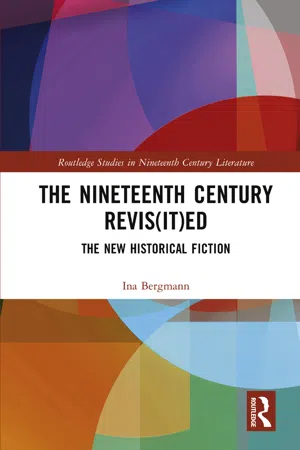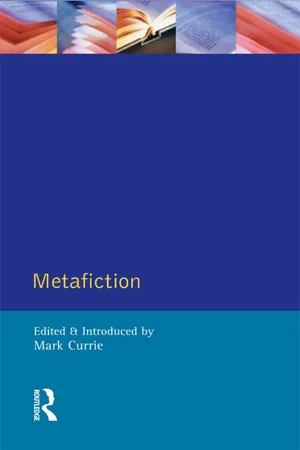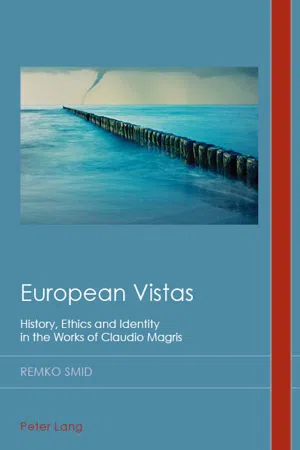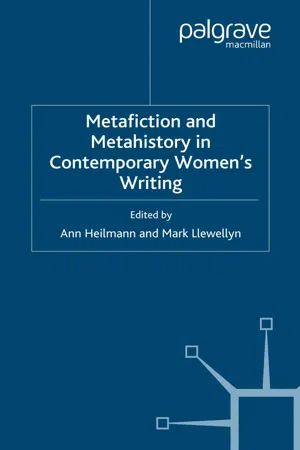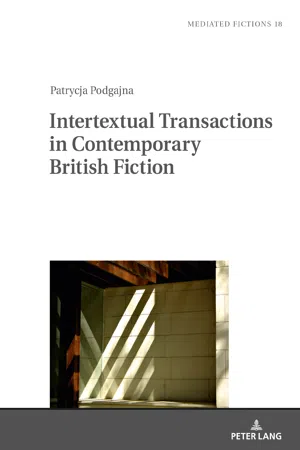Literature
Historiographic Metafiction
Historiographic metafiction is a literary technique that blurs the lines between history and fiction, often by incorporating historical events, figures, or texts into a fictional narrative. It challenges traditional notions of historical truth and explores the ways in which history is constructed and interpreted. This approach encourages readers to critically engage with the relationship between history and storytelling.
Written by Perlego with AI-assistance
Related key terms
1 of 5
11 Key excerpts on "Historiographic Metafiction"
- eBook - ePub
The Nineteenth Century Revis(it)ed
The New Historical Fiction
- Ina Bergmann(Author)
- 2020(Publication Date)
- Routledge(Publisher)
Metahistory (1973), which recognizes the “historical work as … a verbal structure in the form of a narrative prose discourse” (2), they provide the following description: “By ‘metahistorical’ we mean those works of both fiction and nonfiction in which one of the author’s primary contentions is the process of historical narrative itself” (Heilmann/Llewellyn 2).Hutcheon’s term “Historiographic Metafiction” provides such a combination and suggests that such writingrefutes the natural or common sense methods of distinguishing between historical fact and fiction. It refuses the view that only history has a truth claim, both by questioning the ground of that claim in historiography and by asserting that both history and fiction are discourses, human constructs, signifying systems, and both derive their major claim to truth from that identity.(Poetics 93)In the preface toHistoriographic Metafiction in Modern American and Canadian Literature (1994), Bernd Engler und Kurt Müller define Historiographic Metafiction similarly:The post-modern state of consciousness is reflected in the historical novel in numerous and manifold forms of literary self-reflexivity. The use of metafictional narrative techniques that thematize the processuality of writing and the fabricatedness of our mental representations of reality is a prime example of literary self-reflexivity. Post-modern consciousness can also be found in playful, reciprocal superimposition of historiographic and literary discourse, which illustrates to what extent the construction of historiographic plausibility and coherency depends on the use of archetypal narrative “models of world-making.” (9)It is Hutcheon’s further claim “that postmodernists play with history and create a potentially subversive form of cultural critique” (Elias, Sublime xix; see also Kunow, “Making” 195). Historiographic Metafiction is “the most prominent expression of the postmodern attack on the traditional view of art as a realistic or mimetic representation of reality” (Engler 13). Since the publication of Hutcheon’s The Poetics of Postmodernism - eBook - PDF
Alternate History
Playing with Contingency and Necessity
- Kathleen Singles(Author)
- 2013(Publication Date)
- De Gruyter(Publisher)
Such a literature-historical development was hinted at by Jörg Helbig in the concluding remarks to his 1988 study of parahistories, but it was Hutcheon who suggested the term ‘Historiographic Metafiction’ and began to theorize this corpus of texts (“His-toriographic Metafiction” 3). Such works, including Robert Coover’s The Public Burning , Doctorov’s The Book of Daniel, Michael Ondaatje’s Coming through Slaughter , Umberto Eco’s Il nome della rosa , Salman Rushdie’s Midnight’s Chil-dren , Graham Swift’s Waterland , and Thomas Pynchon’s Gravity’s Rainbow , are quintessentially postmodern in that the interaction between history and fiction is one of mutual implication: “Historiographic Metafiction works to situate itself within historical discourse without surrendering its autonomy as fiction.” (2) Hutcheon agrees here with Brian McHale, Nünning, Wesseling, Elias, and other theorists of the postmodern in linking the trends in historiography after 1960 and a general awareness “of the existence and power of systems of repre-sentation which do not reflect […] so much as grant meaning and value” to the program of postmodern fiction (here: Hutcheon, The Politics of Postmodernism 8; see also Nünning 18). Postmodern fiction often thematizes the tensions between 87 It is useful here to dissect Hutcheon’s coinage, for the terms are not parallel in terms of his-torical discourse / fictional discourse: ‘historiographic’ refers merely to the theorizing of history, whereas ‘metafiction’ theorizes about fiction through the practice of writing fiction (cf. by now a classic study: Patricia Waugh, Metafiction 2). Thus, the equivalent to ‘historiography’ in my diagram above is ‘literary criticism’, not ‘metafiction’. - eBook - PDF
Playing with Picturebooks
Postmodernism and the Postmodernesque
- C. Allan(Author)
- 2012(Publication Date)
- Palgrave Macmillan(Publisher)
McCallum (1999, p. 69) points out that history is often presented as a progressive or developmental narrative which utilises ‘linear, chronological, causal and teleological relationships between events and people’ in its rep- resentation of the historical past. Historiographic Metafiction works to unmask these seemingly ‘natural’ features of history by disrupting such frames. This disruption is achieved through the use of many of the metafictive strategies discussed above but aimed specifically at problematising the representations of historiography. This problema- tisation may be either implicit or explicit. The postmodern interrogation of conventional representations of history, namely Historiographic Metafiction, is achieved, according to Hutcheon (1988), through the utilisation of a range of textual strategies that include: mixing historical and fictive elements; dis- ruptions to the ‘objective’, third-person narration of historiography; Interrogating Representations of the Past 97 transgressions of conventions of historiography; challenges to the conventions of narrative; destabilisation of notions of continuity; questioning the status of historiography’s ‘facts’; and the exploita- tion of intertextuality and anachronism. These metafictive strategies reveal the interpretative nature of historical writing, allow critical distance which prevents nostalgia, create uncertainty concerning the evidence provided by historiography, and draw attention to history as a form of textuality, and thus implicated in ideology. While these strategies and their effects on reading positions may seem sophisti- cated they are, nevertheless, utilised across a selection of postmodern picturebooks which endeavour to raise questions about the status of historical knowledge and how this knowledge is conveyed through narrative structures. - eBook - PDF
- Michael J. Hoffman, Patrick D. Murphy, Michael J. Hoffman, Patrick D. Murphy(Authors)
- 2005(Publication Date)
- Duke University Press Books(Publisher)
Histo-riographic metafiction incorporates, but rarely assimilates the data. More often the process of attempting to assimilate is what is foregrounded. Histo-riographic metafiction acknowledges the paradox of the reality of the past but its (only) textualized accessibility to us today. Lukács’s third major defining characteristic of the historical novel is its relegation of historical personages to secondary roles. Clearly, in post-modern novels like Doctor Copernicus, Kepler, Legs ( Jack Diamond), and Antichthon (Giordano Bruno), this is hardly the case. In many historical novels, the real figures of the past are deployed to validate or authenticate the fictional world by their presence, as if to hide the joins between fiction and history in a formal, ontological sleight of hand. The metafictional self-reflexivity of postmodern novels prevents any such subterfuge, and poses - eBook - ePub
- Mark Currie(Author)
- 2014(Publication Date)
- Routledge(Publisher)
per se , just others' truths. Fiction and history are narratives distinguished by their frames (see B.H. Smith 1978), frames which Historiographic Metafiction first establishes and then crosses, positing both the generic contracts of fiction and of history. The postmodern paradoxes here are complex. The interaction of the historiographic and the metafictional foregrounds the rejection of the claims of both ‘authentic’ representation and ‘inauthentic’ copy alike, and the very meaning of artistic originality is as forcefully challenged as is the transparency of historical referentiality.Postmodern fiction suggests that to re-write or to re-present the past in fiction and in history is, in both cases, to open it up to the present, to prevent it from being conclusive and teleological. Such is the teaching of novels like Susan Daitch's L.C. , with its double layer of historical reconstruction, both of which are presented with metafictional self-consciousness. Parts of the journal of the fictive protagonist, Lucienne Crozier, a woman implicated in, yet marginalized as a witness of the historical 1848 revolution in Paris, are edited and translated twice: once by Willa Rehnfield and once by her younger assistant after her death. The recent interest in archival women's history is given an interesting new twist here, for the two translations of the end of Lucienne's diary are so vastly different that the entire activity of translation, as well as research, is called into question. In the more traditional Willa's version, Lucienne dies of consumption in Algiers, abandoned by her revolutionary lover. In the version of her more radical assistant (a veteran of Berkeley in 1968, being sought by the police for a terrorist bombing), Lucienne just stops writing, while awaiting arrest for revolutionary activities.Other Historiographic Metafictions point to other implications of the rewriting of history. Ian Watson's Chekhov's Journey opens in the manner of a historical novel about Anton Chekhov's 1890 trip across Siberia to visit a convict colony. The next chapter, however, sets up a tension between this and a 1990 frame: at a Russian Artists' Retreat in the country, a film-maker, a scriptwriter, and a Chekhov look-alike actor meet to plan a him about that historical trip of 1890. The plan is to hypnotize the actor and tape his entry into Chekhov's personality and past. From these tapes, a script will emerge. However, they encounter a serious problem: the actor begins to alter the dates of verifiable historical events, moving the Tunguska explosion from 1888 to 1908. We are told that, from this point on, ‘the film project foundered further into a chaos of unhistory’ (1983, 56). Suddenly a third narrative intervenes: a spaceship in the future is about to launch backwards into time past. (Meanwhile, at the Retreat, fog isolates the writing team in a timeless world; telephone circuits turn back on themselves; all links to the outside are cut.) The spaceship commander realizes that he is experiencing the rewriting of history: the 1908 explosion has regressed and become that of 1888, and both prefigure (repeat?) atomic blasts of an even later date. He is caught in a time loop which renders any firm sense of history or reality impossible. (At the Retreat, new books are found in the library, rewritten versions, not of history, but of literature: Apple Orchard, Uncle Ivan, Three Cousins, Snow Goose - eBook - PDF
The Postmodern Fairytale
Folkloric Intertexts in Contemporary Fiction
- Kevin Paul Smith(Author)
- 2007(Publication Date)
- Palgrave Macmillan(Publisher)
We have seen above that the novels under analysis here all raise questions about the domain of historiography, from the problems of autobiographical writing to the representation of historic events, and the difficulties raised by this trope have forced us to reconsider our prejudices about literary realism, omniscient narration, history and autobiography. Hutcheon claims that Midnight’s Children, Nights at the Circus and Waterland are all prime examples of histori- ographic metafiction because of the way they question historiography and counter history as a ‘grand narrative’ with history on the human scale. One of the primary ways that these texts question historiography’s status as a grand narrative, separate from fiction, is by incorporating a storyteller, alerting readers to the constructs that determine how we read a text: the construct of the author, the split subject of author and narrator, the effacement of the individualised subject and subjectivity caused by omniscient narration, the genre of fiction and the idea of representation. Metafictive Intertextuality 117 Cazzato, in his analysis of metafiction, argues that contemporary metafiction is the product of postmodern or late capitalist society. By foregrounding the author, texts that Cazzato classes as ‘hard’ metafic- tion act to reinscribe the narrating subject. He suggests that Roland Barthes, in his famous essay ‘The Death of the Author’, had ‘fallen into the trap of reification’, and that metafiction acts to try and remind the reader of the originating subject: by applying a Marxian reading we can see that the story-as-commodity produces the same sense of alienation as any other reified product, it appears to have just magically ‘appeared’ to the reader, who has no sense of who the author really is, or why they write. - eBook - ePub
W.G. Sebald’s Hybrid Poetics
Literature as Historiography
- Lynn L. Wolff(Author)
- 2014(Publication Date)
- De Gruyter(Publisher)
159Whether we talk of Historiographic Metafiction or metahistorical novels, these forms are not the only ones that have a privileged access to the (re)construction of the past in the twentieth century. Ankersmit describes a “personalization or privatization of our relationship to the past,” which is manifested in the “sudden predominance of the notion of memory” in twentieth-century historical representation.160 Aleida Assmann points to the separation of history from memory that occurred alongside the professionalization of the discipline of history in the nineteenth century as well as the way the two have begun to converge again since the 1980s.161 Oral history has played a significant role in this development and is relevant to the discussion at hand, for it is a form of historical investigation that reveals both a desire for more immediate access to the past and an awareness of the role human influence plays in the construction of the past.162 Assmann points to the connection between oral history and Holocaust research in particular, namely the revaluation of survivor testimonies, highlighting how such forms of witnessing both document the past from an intimately personal perspective and serve a memorial function.163 In a similar vein to oral history, “Alltagsgeschichte,” or history of the everyday, has been an important development in reconsidering the role of personal memory in official forms of historiography. Andrea Albrecht highlights how historians of the everyday undertake microhistorical investigation of letters, memories, and interviews of contemporary witnesses, referring to Christopher Browning’s Ordinary Men as a significant contribution to the development of this methodology.164 - eBook - PDF
European Vistas
History, Ethics and Identity in the Works of Claudio Magris
- Remko Smid(Author)
- 2019(Publication Date)
- Peter Lang Group(Publisher)
He views metafiction as ‘a borderline discourse, as a kind of writing which places itself on the border between fiction and criticism, and which takes that border as its subject’ (1995: 2). This does not mean 6 Wesseling discusses political history as an introduction of postmodernist historical fiction. She refers to Robert Coover’s The Public Burning (1977) and Jay Cantor’s The Death of Che Guevara (1983). 7 The use of metafiction actually goes back centuries, for instance, to Shakespeare and Chaucer (Currie, 1995: 5). ‘Writing a historical novel means throwing oneself into the chaos of history’ 21 that the novelist of metafiction also has to be a critic (although Magris is), but it entails that the metafictional novel dramatizes the boundary between fiction and criticism (1995: 3) or signifies it as self-commentary (1995: 5). The latter is the case in Magris’ fiction, particularly in his later novels, which highlight their fictitiousness. Modernist and postmodernist techniques may not only offer a more accurate representation of events – as White indicates – but can also be used for analytical purposes. Although Magris’ fiction does not so much dramatize the distinction between fiction and criticism, it often func- tions as criticism through the metanarrative reflections it has to offer the reader. Moreover, as we will see, we find Hutcheon’s characteristics of Historiographic Metafiction in Magris’ novels, particularly in his later work. The postmodernist, but also the modernist techniques found in his novels are not only used to narrate the past, but also highlight the problem of historical reference, in several self-reflexive ways. One of these is the emphasis on history as a narrative construct, while the other self-reflexive elements are related to this narrativity: the accentuation of intertextual- ity, subjectivity, partiality and unreliability. - A. Heilmann, M. Llewellyn(Authors)
- 2007(Publication Date)
- Palgrave Macmillan(Publisher)
9 Of these, Hutcheon’s A Poetics of Postmodernism (1988) has been the most influential, and the term ‘Historiographic Metafiction’ is used frequently in critical discourse as a short-hand for the kinds of theorized approaches to the historical in literature which have become part of mainstream culture since her book was published. Hutcheon’s own definition of the term suggests how it refutes the natural or common-sense methods of distinguishing between historical fact and fiction. It refuses the view that only 4 Introduction history has a truth claim, both by questioning the ground of that claim in historiography and by asserting that both history and fiction are discourses, human constructs, signifying systems, and both derive their major claim to truth from that identity. 10 Given that history and fiction are both grounded in narrative, the two remain interdependent on one another. Historical fiction could there- fore be viewed as the quintessential mode of postmodernism, in that it continually raises questions and concerns about the very fabric of the past and the present. As Hutcheon writes, ‘[p]ostmodern fiction suggests that to re-write or to re-present the past in fiction and history is, in both cases, to open it up to the present, to prevent it from being conclusive and teleological.’ 11 The distinctive feature of such fictions in Hutcheon’s view is to be found in their eagerness to explore how narratives and histories work within and around one another. 12 It was Hayden White, almost thirty years ago, who argued that this relationship be explored for what it could teach both historians and creative artists about the role, status and authority of historical narrative.- Patrycja Podgajna(Author)
- 2021(Publication Date)
- Peter Lang Group(Publisher)
CHAPTER IV: DEFERRING OBJECTIVE REPRESENTATION OF THE PAST IN Historiographic Metafiction But… who is to say what is real and what unreal? (Ackroyd 35) …that past is the past cannot be checked. What is remembered is. Whether it were fact or fantasy, doing or dream, memory makes it history. And if there is evidence remaining from time gone, letters or documents or other witnesses, letters may be forged and documents may be untrustworthy and other witnesses may suffer from mass hallucinations. (Sinclair 175) 4.1 Introduction The reliance on referentiality, imitation and boundary-crossing delin- eated so far in the process of literary adaptation, pastiche and transworld- identification is indicative of yet another intertextual practice in postmodern oeuvre – Historiographic Metafiction� Juxtaposing past and present, history and myth, fact and fiction, this postmodern convention and intertextual practice explores the ways in which historical fiction self-reflexively alludes to textualised historical facts, uses historical discourse or incorporates real- world figures into fictional contexts so as to conflate history and fact� In doing so, Historiographic Metafiction not only borrows or transforms prior texts and sources, but it also problematises the continuity and objectivity of historical representation� An elaborate explanation of this propensity is pro- vided by Linda Hutcheon who, in The Politics of Postmodernism, defines Historiographic Metafiction as fiction “where documentary historical actu- ality [or ‘realist representation’] meets formalist self-reflexivity and parody”- eBook - PDF
Narrating the Past
Historiography, Memory and the Contemporary Novel
- A. Robinson(Author)
- 2011(Publication Date)
- Palgrave Macmillan(Publisher)
Part One Historiography and Fiction 3 1 The Narrative Turn in History The question of whether ‘the discipline of history is essentially a narra- tive mode of knowing, understanding, explaining and reconstructing the past’ has been described as ‘the most important and central debate in the philosophy of history since the 1960s’. 1 As this debate has developed, historiography has undergone a linguistic turn inspired by structuralist and poststructuralist thought, leading to the emergence of so-called post- modernist history. 2 Since the 1980s this has had a considerable impact on how literary scholars and novelists have thought about the past, pro- voking a historical turn evident in new historicism and the emergence of Historiographic Metafiction. Literary scholars have, however, devoted disproportionate attention to limited aspects of historiography. Popularising Hayden White, they have celebrated the supposed assimilation of history to fiction, and emphasised the situatedness of historical discourse and its connections with hegemonic power. But they have neglected several fundamental issues common to historiography and historical fiction.
Index pages curate the most relevant extracts from our library of academic textbooks. They’ve been created using an in-house natural language model (NLM), each adding context and meaning to key research topics.
